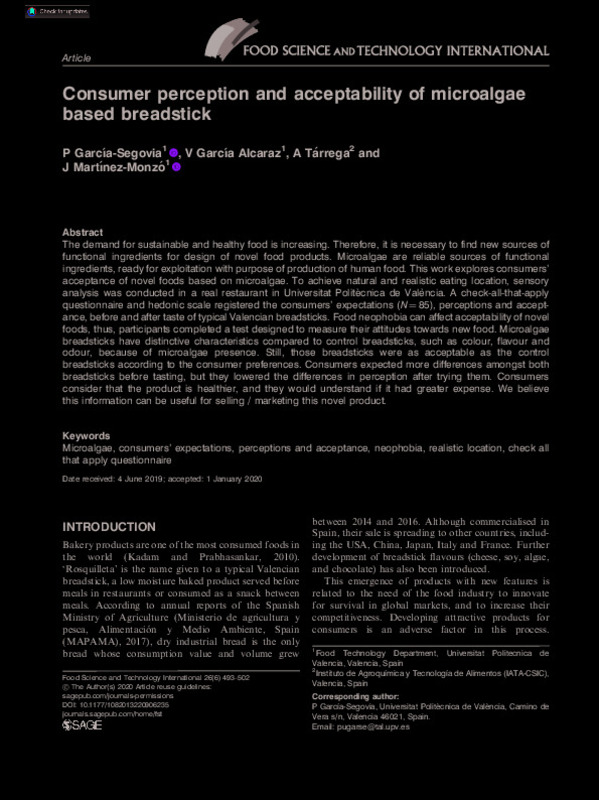JavaScript is disabled for your browser. Some features of this site may not work without it.
Buscar en RiuNet
Listar
Mi cuenta
Estadísticas
Ayuda RiuNet
Admin. UPV
Consumer perception and acceptability of microalgae based breadstick
Mostrar el registro sencillo del ítem
Ficheros en el ítem
| dc.contributor.author | García-Segovia, Purificación
|
es_ES |
| dc.contributor.author | García Alcaraz, V.
|
es_ES |
| dc.contributor.author | Tárrega, A.
|
es_ES |
| dc.contributor.author | Martínez Monzó, Javier
|
es_ES |
| dc.date.accessioned | 2023-05-05T18:01:32Z | |
| dc.date.available | 2023-05-05T18:01:32Z | |
| dc.date.issued | 2020-09 | es_ES |
| dc.identifier.issn | 1082-0132 | es_ES |
| dc.identifier.uri | http://hdl.handle.net/10251/193172 | |
| dc.description.abstract | [EN] The demand for sustainable and healthy food is increasing. Therefore, it is necessary to find new sources of functional ingredients for design of novel food products. Microalgae are reliable sources of functional ingredients, ready for exploitation with purpose of production of human food. This work explores consumers' acceptance of novel foods based on microalgae. To achieve natural and realistic eating location, sensory analysis was conducted in a real restaurant in Universitat Politecnica de Valencia. A check-all-that-apply questionnaire and hedonic scale registered the consumers' expectations (N = 85), perceptions and acceptance, before and after taste of typical Valencian breadsticks. Food neophobia can affect acceptability of novel foods, thus, participants completed a test designed to measure their attitudes towards new food. Microalgae breadsticks have distinctive characteristics compared to control breadsticks, such as colour, flavour and odour, because of microalgae presence. Still, those breadsticks were as acceptable as the control breadsticks according to the consumer preferences. Consumers expected more differences amongst both breadsticks before tasting, but they lowered the differences in perception after trying them. Consumers consider that the product is healthier, and they would understand if it had greater expense. We believe this information can be useful for selling / marketing this novel product. | es_ES |
| dc.language | Inglés | es_ES |
| dc.publisher | SAGE Publications | es_ES |
| dc.relation.ispartof | Food Science and Technology International | es_ES |
| dc.rights | Reconocimiento (by) | es_ES |
| dc.subject | Microalgae | es_ES |
| dc.subject | Consumers' expectations | es_ES |
| dc.subject | Perceptions and acceptance | es_ES |
| dc.subject | Neophobia | es_ES |
| dc.subject | Realistic location | es_ES |
| dc.subject | Check all that apply questionnaire | es_ES |
| dc.subject.classification | TECNOLOGIA DE ALIMENTOS | es_ES |
| dc.title | Consumer perception and acceptability of microalgae based breadstick | es_ES |
| dc.type | Artículo | es_ES |
| dc.identifier.doi | 10.1177/1082013220906235 | es_ES |
| dc.rights.accessRights | Abierto | es_ES |
| dc.contributor.affiliation | Universitat Politècnica de València. Escuela Técnica Superior de Ingeniería Agronómica y del Medio Natural - Escola Tècnica Superior d'Enginyeria Agronòmica i del Medi Natural | es_ES |
| dc.description.bibliographicCitation | García-Segovia, P.; García Alcaraz, V.; Tárrega, A.; Martínez Monzó, J. (2020). Consumer perception and acceptability of microalgae based breadstick. Food Science and Technology International. 26(6):493-502. https://doi.org/10.1177/1082013220906235 | es_ES |
| dc.description.accrualMethod | S | es_ES |
| dc.relation.publisherversion | https://doi.org/10.1177/1082013220906235 | es_ES |
| dc.description.upvformatpinicio | 493 | es_ES |
| dc.description.upvformatpfin | 502 | es_ES |
| dc.type.version | info:eu-repo/semantics/publishedVersion | es_ES |
| dc.description.volume | 26 | es_ES |
| dc.description.issue | 6 | es_ES |
| dc.identifier.pmid | 32070143 | es_ES |
| dc.relation.pasarela | S\406538 | es_ES |








